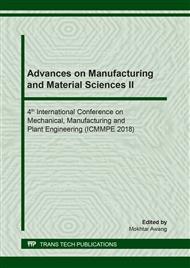[1]
Buthaina A. Ibrahim, & Karrer M. Kadum. (2010). Influence of polymer blending on mechanical and thermal properties. Modern Applied Science, 4 (9), 157-161.
Google Scholar
[2]
A. Dorigato, A. Pegoretti, L. Fambri, C. Lonardi, M. Slouf, & J. Kolarik. (2010). Linear low density polyethylene/cycloolefin copolymer blends. eXpress Polymer Letter, 5(1), 23-37.
DOI: 10.3144/expresspolymlett.2011.4
Google Scholar
[3]
I. Krupa, & A.S. Luyt. (2001). Physical properties of blends of LLDPE and an oxidized paraffin wax. Polymer, 42, 7285-7289.
DOI: 10.1016/s0032-3861(01)00172-0
Google Scholar
[4]
A. S. Luyt, J. A. Molefi, & H. Krump. (2006). Thermal, mechanical and electrical properties of copper powder filled low-density and linear low-density polyethylene composites. Polymer Degradation and Stability, 91, 1629-1636.
DOI: 10.1016/j.polymdegradstab.2005.09.014
Google Scholar
[5]
Hossein Ali Khonakdar. (2015). Dynamic mechanical analysis and thermal properties of LLDPE/EVA/modified silica nanocomposites. Composites Part B, 76, 343-353.
DOI: 10.1016/j.compositesb.2015.02.031
Google Scholar
[6]
Ruowen Zong, Zhengzhou Wang, Naian Liu, Yuan Hu, & Guanxuan Liao. (2005). Thermal degradation kinetics of polyethylene and silane crosslinked polyethylene. Journal of Applied Polymer Science, 98, 1172-1179.
DOI: 10.1002/app.22124
Google Scholar
[7]
Vinny R. Sastri. (2014). 8-high-temperature engineering thermoplastics: Polysulfones, polyimides, polysulfides, polyketones, liquid crystalline polymers, and fluoropolymers. Plastics in Medical Devices Properties, Requirements and Applications, (2nd ed., pp.173-213), New York, NY: Elsevier.
DOI: 10.1016/b978-0-323-85126-8.00001-1
Google Scholar
[8]
Gcina Doctor Vilakati, Eric M. V. Hoek, & Bhekie Brilliance Mamba. (2014). Probing the mechanical and thermal properties of polysulfone membranes modified with synthetic and natural polymer addictives. Polymer Testing, 34, 202-210.
DOI: 10.1016/j.polymertesting.2014.01.014
Google Scholar
[9]
Mariana Ionita, Andreea Madalina Pandele, Livia Crica, & Luisa Pilan. (2014). Improving the thermal and mechanical properties of polysulfone by incorporation of graphene oxide. Composites Part B : Engineering, 59, 133-139.
DOI: 10.1016/j.compositesb.2013.11.018
Google Scholar


